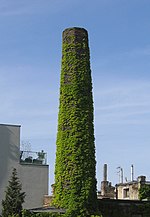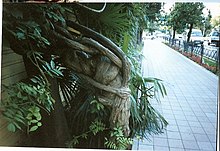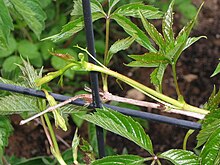User:Mellis/vine


A vine (Latin vīnea "grapevine", "vineyard", from vīnum "wine") in the narrowest sense is the grapevine (Vitis), but more generally it can refer to any plant with a growth habit of trailing or scandent (that is, climbing) stems or runners. The word also can refer to such stems or runners themselves, for instance when used in wicker work.[1][2]
In the United Kingdom, the term "vine" applies almost exclusively to the grapevine. The term "climber" is used for all climbing plants.[3]
Growth forms
[edit]

Certain plants always grow as vines, while a few grow as vines only part of the time. For instance, poison ivy and bittersweet can grow as low shrubs when support is not available, but will become vines when support is available.[4]
A vine displays a growth form based on long stems. This has two purposes. A vine may use rock exposures, other plants, or other supports for growth rather than investing energy in a lot of supportive tissue, enabling the plant to reach sunlight with a minimum investment of energy. This has been a highly successful growth form for plants such as kudzu and Japanese honeysuckle, both of which are invasive exotics in parts of North America. There are some tropical vines that develop skototropism, and grow away from the light, a type of negative phototropism. Growth away from light allows the vine to reach a tree trunk, which it can then climb to brighter regions.[5]
The vine growth form may also enable plants to colonize large areas quickly, even without climbing high. This is the case with periwinkle and ground ivy. It is also an adaptation to life in areas where small patches of fertile soil are adjacent to exposed areas with more sunlight but little or no soil. A vine can root in the soil but have most of its leaves in the brighter, exposed area, getting the best of both worlds.
The evolution of a climbing habit has been implicated as a key innovation associated with the evolutionary success and diversification of a number of taxonomic groups of plants.[6] It has evolved independently in several plant families, using many different climbing methods[7] such as:
- twining their stems around a support (e.g., morning glories, Ipomoea species).
- by way of adventitious, clinging roots (e.g., ivy, Hedera species)
- with twining petioles (e.g., Clematis species)
- using tendrils, which can be specialized shoots (Vitaceae), leaves (Bignoniaceae), or even inflorescences (Passiflora)
- using tendrils which also produce adhesive pads at the end that attach themselves quite strongly to the support, (Parthenocissus)
- using thorns (e.g. climbing rose) or other hooked structures, such as hooked branches (e.g. Artabotrys hexapetalus)
The climbing fetterbush (Pieris phillyreifolia) is a woody shrub-vine which climbs without clinging roots, tendrils, or thorns. It directs its stem into a crevice in the bark of fibrous barked trees (such as bald cypress) where the stem adopts a flattened profile and grows up the tree underneath the host tree's outer bark. The fetterbush then sends out branches that emerge near the top of the tree.[8]

Most vines are flowering plants. These may be divided into woody vines or lianas, such as wisteria, kiwifruit, and common ivy, and herbaceous (nonwoody) vines, such as morning glory.
One odd group of vining plants is the fern genus Lygodium, called climbing ferns.[9] The stem does not climb, but rather the fronds (leaves) do. The fronds unroll from the tip, and theoretically never stop growing; they can form thickets as they unroll over other plants, rockfaces, and fences.
Climbers
[edit]Liana
[edit]"climbing herbaceous or woody plant with small stem diameter; = climber, which is preferred." Under "Climber" it says "a plant that grows upwards by attaching itself to other structures which it uses as supports; by contrast, a scrambler does not attach itself to its supports."
Vitaceae
[edit]Twining
[edit]
R: Right-handed or anticlockwise bine
Non-climbing
[edit]Use as garden plants
[edit]Gardeners can use the tendency of climbing plants to grow quickly. If a plant display is wanted quickly, a climber can achieve this. Climbers can be trained over walls, pergolas, fences, etc. Climbers can be grown over other plants to provide additional attraction. Artificial support can also be provided. Some climbers climb by themselves; others need work, such as tying them in and training them.
Examples
[edit]
- Actinidia arguta, the tara vine
- Actinidia polygama, the silver vine
- Adlumia fungosa, the Allegheny vine
- Aeschynanthus radicans, the lipstick vine
- Akebia, the chocolate vine
- Ampelocissus acetosa, known as wild grape or djabaru
- Ampelopsis glandulosa var. brevipedunculata, known as wild grape or porcelain berry
- Anredera cordifolia
- Antigonon, the coral vine
- Antigonon leptopus, the confederate vine
- Berchemia scandens, the rattan vine
- Bignonia, the cross vine
- Bougainvillea, a genus of thorny ornamental vines, bushes, and trees
- Campsis, the trumpet vine
- Campsis grandiflora, the Chinese trumpet vine
- Cardiospermum halicacabum, the balloon vine
- Celastrus, the staff vine
- Ceropegia linearis, the rosary vine or sweetheart vine
- Cissus antarctica, the kangaroo vine
- Cissus hypoglauca, the water vine
- Cucumis sativus, the cucumber
- Cyphostemma juttae, known as wild grape
- Fallopia baldschuanica, the Russian vine
- Hedera helix, known as common ivy, English ivy, European ivy, or ivy
- Kennedia coccinea, the common coral vine
- Lagenaria siceraria, known as the bottle gourd, calabash, opo squash, or long melon
- Lathyrus odoratus, the sweet pea
- Lonicera japonica, known as Suikazura or Japanese honeysuckle
- Luffa, a genus of tropical and subtropical vines classified in the cucumber (Cucurbitaceae) family
- Lygodium, a genus of about 40 species of ferns, known as climbing ferns
- Momordica charantia, the bitter gourd
- Mikania scandens, the hemp vine
- Muehlenbeckia adpressa, the macquarie vine
- Nepenthes, a genus of carnivorous plants known as tropical pitcher plants or monkey cups
- Pandorea pandorana, the wonga wonga vine
- Parthenocissus quinquefolia, known as the Virginia creeper, Victoria creeper, five-leaved ivy, or five-finger
- Passiflora edulis, the passionfruit
- Periploca graeca, the silk vine
- Podranea ricasoliana, the pink trumpet vine
- Pueraria lobata, the kudzu vine
- Scindapsus pictus, the silver vine
- Sechium edule, known as chayote, christophene, or several other names
- Solandra, a genus of flowering plants in the nightshade family
- Solanum laxum, the potato vine
- Strongylodon macrobotrys, the jade vine
- Syngonium, the goosefoot vine
- Syngonium podophyllum, the arrowhead vine
- Thunbergia grandiflora, known as the Bengal clock vine or blue trumpet vine
- Thunbergia erecta, the bush clock vine
- Toxicodendron radicans, known as poison ivy
- Vitis, any of about sixty species of grape
- Wisteria, a genus of flowering plants in the pea family
See also
[edit]- Vine (disambiguation)
- Bine (botany), a type of plant similar to and often confused with vines.
- Liana, any of various long-stemmed, woody vines
- Vine training systems
References
[edit]- ^ Brown, Lesley (1993). The New shorter Oxford English dictionary on historical principles. Oxford [Eng.]: Clarendon. ISBN 0-19-861271-0.
- ^ Jackson, Benjamin, Daydon; A Glossary of Botanic Terms with their Derivation and Accent; Published by Gerald Duckworth & Co. London, 4th ed 1928
- ^ Shorter Oxford English dictionary, 6th ed. United Kingdom: Oxford University Press. 2007. p. 3804. ISBN 0199206872.
- ^ "Creepers". mannuthynursery. Retrieved 17 July 2013.
- ^ Glimn-Lacy, Janice; Kaufman, Peter B. (2006). Botany Illustrated. Springer.
- ^ Gianoli, Ernesto (2004). "Evolution of a climbing habit promotes diversification in flowering plants". Proceedings of the Royal Society B: Biological Sciences. 271 (1552): 2011–2015. doi:10.1098/rspb.2004.2827. PMC 1691831. PMID 15451690.
- ^ Francis E. Putz. "Vine Ecology". Retrieved 2012-03-01.
- ^ Alan Weakley Flora of the Southern and Mid-Atlantic States (2010) p661
- ^ "Japanese climbing fern". Center for Aquatic and Invasive Plants. Retrieved 17 July 2013.
External links
[edit]- The oldest vine in the world
- Beach, Chandler B., ed. (1914). . . Chicago: F. E. Compton and Co.
